Recently, manufacturers are increasingly equipping their vacuum cleaners with convenient self-cleaning stations. These innovations are designed to make the user experience easier and eliminate the need for people to waste time maintaining a vacuum cleaner. In our test laboratory, we conducted a thorough study of the effectiveness of self-cleaning systems after dry and wet cleaning in various models of vacuum cleaners.
Robot vacuum cleaners with self-cleaning stations
Robot vacuum cleaners were originally designed to automate cleaning and free users from this concern. However, the process of cleaning the robot itself (the dust container, brushes, filters, wet cleaning cloths, and, if necessary, the water tank) requires time and effort. To eliminate this inconvenience, robot vacuum cleaners are now often equipped with… another robot that cleans the first one. This second robot is a self-cleaning station, and its functionality may vary depending on the model.
Self-cleaning after dry cleaning
The technology, which is now presented as innovative, was implemented by Karcher many years ago: their robot vacuum cleaner returned to the base, where the collected garbage was pulled into a filter bag installed in it. There was also a more powerful vacuum cleaner inside the base that removed dust and debris from the plastic dust bin. The bags had to be replaced as they were filled — about once every one and a half to two months. This is how dry self-cleaning works in modern robots with self-cleaning stations.
Thus, the robot transfers garbage from the container to the bag, but there are also filters — motor, exhaust, and a central rotor brush, on which hair and animal fur can be wound. They are also susceptible to contamination and require cleaning. During testing, we found that the filters were successfully cleaned, which significantly increased the performance of the vacuum cleaner and extended the life of the filters themselves. Some manufacturers may be overly careful: for example, the instructions for the iLife T10s robot with a self-cleaning base recommend emptying the container after each cleaning, but during testing we were convinced that the base cleans the trash can perfectly. These instructions in the instructions should not be cause for concern: they are likely to apply to the entire line of robots, and this instruction most likely applies to simple models without a self-cleaning base.
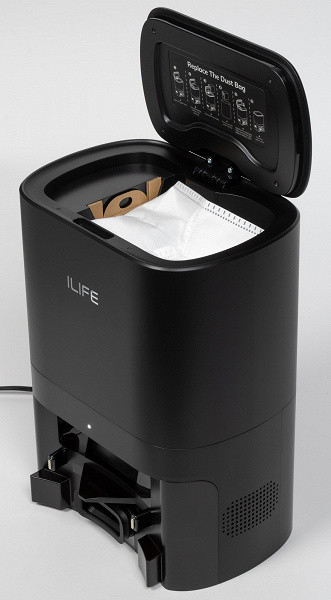
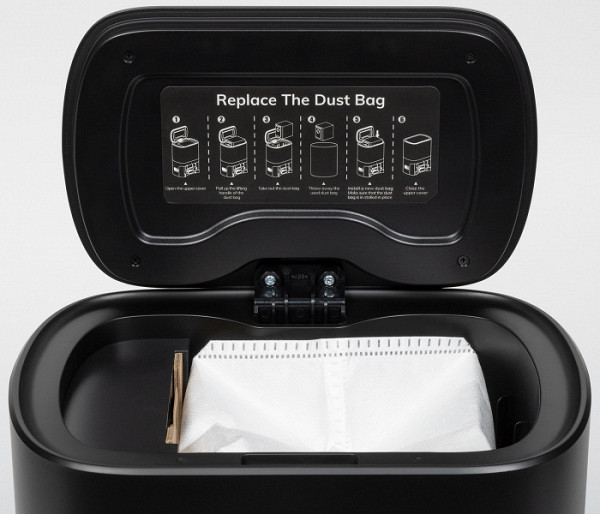
But in all cases the central rotary brush will have to be cleaned manually by removing it from the body and removing it or cutting it and pulling out the wound part.

Some models, such as the Hobot Legee D8, have a special mode to prevent fur and hair from clogging the central brush. In this mode, the rotation speed of the brush can be reduced or completely turned off, and the dust inlet is increased, which allows you to immediately suck the hair inside, avoiding it from wrapping around the rotor.
However, more thorough manual cleaning of the dust bin may be required from time to time. This is indicated in most instructions, and is also a necessity in everyday life, as some debris may get stuck in the container.
Self-cleaning after wet cleaning
Robot vacuum cleaners equipped with a wet cleaning function perform it in two ways. The first method is to simply wipe the floor with microfiber soaked in water, which allows you to collect very fine dust left uncollected by the robot. Typically, water is supplied from a special reservoir directly to a napkin, which is attached to the bottom of the case. The user has to put on and take off this cloth, as well as clean, wash and dry it, even if the vacuum cleaner has a self-cleaning station to pull dust from the dust container and filters into the bag.
The second method is a more intensive floor cleaning, where water is supplied to the washing fixtures or from a large reservoir in the base, and then dirty waste water is sucked into a separate reservoir. The user will still have to throw out the dirty water, but some models, such as the Uwant U200, offer the function of washing and drying wipes in the base's built-in tray, followed by warm air drying. This allows you to keep the wipes clean and prevent the appearance of an unpleasant odor, but the user will still have to fill the station with water and empty the dirty water.
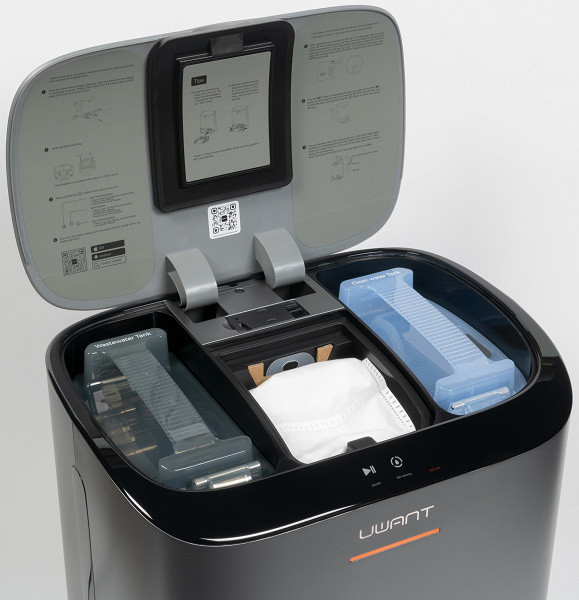
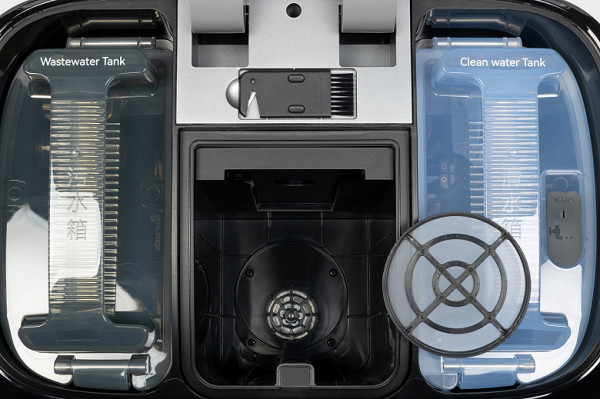
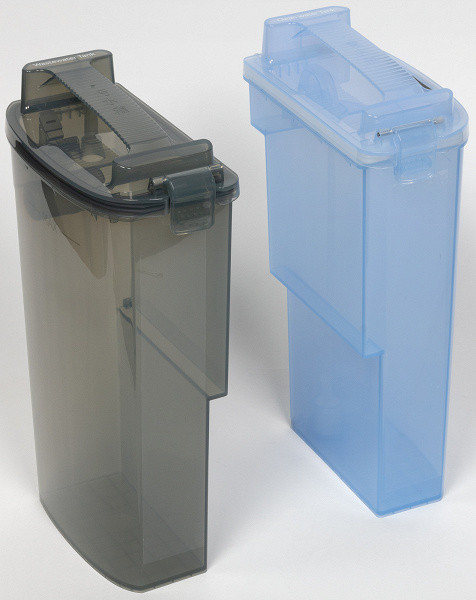

Another example is the Hobot Legee D8 robot, which can be supplemented with the Hobot Legee Lulu station (this is optional, the robot can be purchased without it). The station allows you to clean up after the robot only once every week or two to change the water in the tanks. It is synchronized with the robot and controlled through the same application as the vacuum cleaner itself. You can turn on or off the washing and drying of napkins, set the station to start after each cleaning of the entire room, a separate room, or by time. Upon completion of cleaning, the robot drives up to the station, and the napkin appears above the movable module, which rinses it with clean water, and the dirty water is poured into a special container. This process takes about 5 minutes, but drying can take anywhere from 2 to 4 hours depending on the time selected.
Although this is basic care for napkins and mops and helps keep them relatively clean, they still need to be washed periodically in the washing machine (which is often allowed in the instructions) or by hand and then dried.
Some self-cleaning stations only remove dust from the dust container and filters, leaving the maintenance of the wet wipes and water reservoir to the user. If this care is not performed in a timely manner, a puddle may form under the robot, and the wipes may begin to smell bad, such as with the Honor Choice Robot Cleaner R2 Plus/ROB-01.
Cleaning station connected to water supply and sewerage
Finally, regarding the latest developments in self-cleaning, our lab recently tested the Dreame RAW4 kit. This kit is designed to automatically replenish the tank of the self-cleaning station of the Dreame L20 and Dreame L30 robotic vacuum cleaners with tap water, as well as to drain dirty liquid into the sewer. We successfully connected it to our L30 Ultra robot.
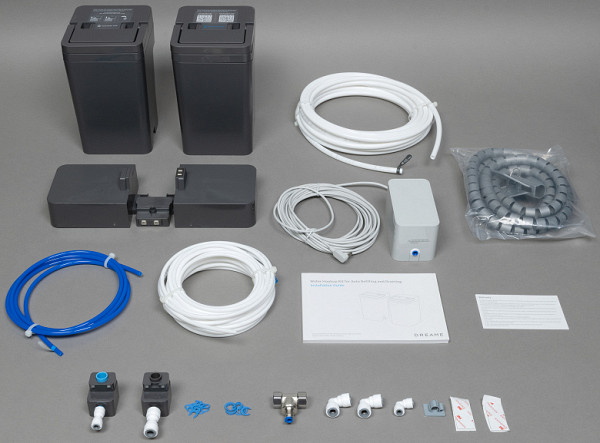

The main task when connecting the kit is to choose the location of the base station of the vacuum cleaner, which requires at least 1.5 m of free space in front of it, as well as the proximity of the outlet. It is also important to consider the route of laying water and sewer hoses. However, the connection process itself is not so complicated: the instructions are detailed, and the design of the device and the entire system is well thought out. In the delivery set, the standard water tanks in the base of the vacuum cleaner are replaced with others from the kit. When first launched, the station automatically recognizes a new connected object in the application, after which it can be controlled remotely. It is especially convenient that the application warns about possible errors, for example, in the assembly.

We did not like the lack of control over possible leaks: the system is not equipped with appropriate sensors, and the line does not shut off in case of damage. However, this disadvantage can be corrected by installing mechanical valves.
After installing the system, using the vacuum cleaner has become more comfortable: you no longer need to worry about timely emptying the tank with dirty liquid or filling the tank with clean water. The station itself controls filling and draining, and the user only requires simple maintenance. To maintain the system, it is enough to periodically inspect the internal filter of the tank with dirty liquid and empty it if necessary. Then it is advisable to rinse the nylon mesh under running water and return it to its place.
Upright cordless vacuum cleaners
Upright vacuum cleaners were originally designed for quick cleaning, but are now increasingly used as a replacement for larger corded models, not only because of the quality of cleaning, but also because of their convenience and quick readiness for work. Therefore, the improvement of cordless upright vacuum cleaners is aimed at reducing the time and effort of the user. In the case of self-cleaning stations, the goal is also to reduce the time required to maintain the vacuum cleaner and dispose of waste. However, another important aspect is that the dust bin automatically empties and traps debris in the filter bag, eliminating user contact with dust. Despite the efforts and assurances of manufacturers, emptying the container by pressing a button is almost impossible due to possible jams. During our tests, we looked at how the self-cleaning station affected this problem, and we were pleased with the results.
For example, the Dreame Z10 Station VPV17A upright vacuum cleaner requires virtually no cleaning or manual maintenance thanks to a base that pulls dust out of the dustbin and cleans the filter. However, sometimes it may still be necessary to remove the garbage container and clean it, especially if large debris gets stuck at the junction of the suction pipe and the container. But in general, the base copes with this task: we specially filled the container with garbage to check this.

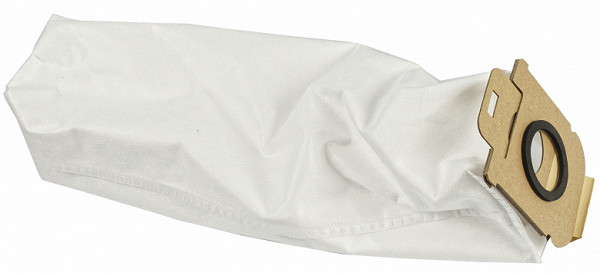

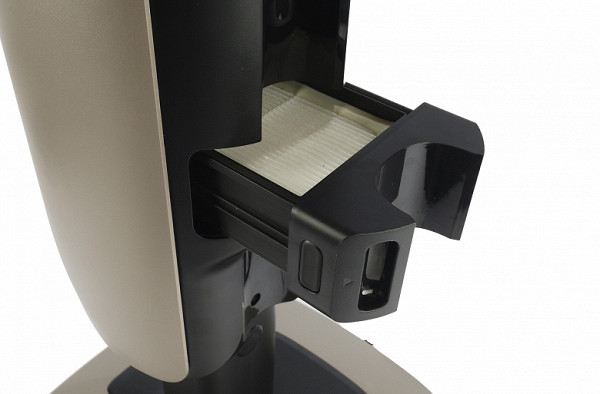


Upright cordless vacuum cleaners are increasingly equipped with a scrubbing function, and some also come with self-cleaning stations (which, unlike vacuum cleaners, are powered). An example of such a device is the Redmond RV-UR368, which has UV disinfection and self-cleaning functions. A nice bonus is a female voice that reminds you to clean the vacuum cleaner itself.

Although the voice assistant can be turned off, the user will have to run the self-cleaning program on the base themselves, as it does not activate automatically. To do this, you need to pour out the dirty water collected by the vacuum cleaner, pour in clean water, place the stick on the base and press the appropriate button to activate the self-cleaning program. The self-cleaning process lasts a minute: the vacuum cleaner pumps water from a clean tank into a dirty one, and then drains it into a tray under the main nozzle. After this, it is necessary to remove and rinse both water containers, as well as the tray. As for washing the rotor brushes, this must be done manually, although the base has a stand for drying them.
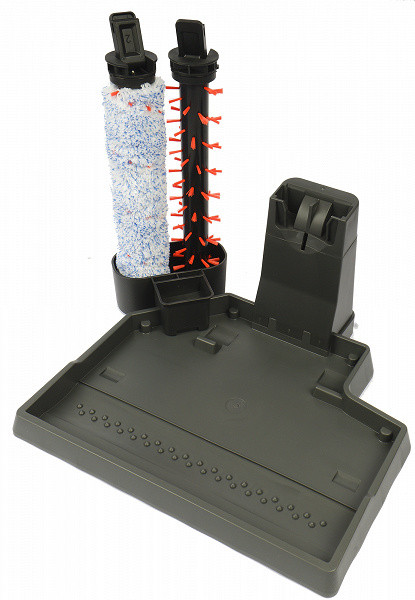
How complete such self-cleaning is is for the customers to judge, but the main thing is that we liked washing the floor, and the tanks are actually cleaned, and that’s all that was stated by the manufacturer.
Self-cleaning systems for vacuum cleaners, whether robotic or upright battery-powered models, are still far from ideal autonomy, especially in the context of wet cleaning. However, there have been some advances in cleaning robots after dry cleaning and in washing and drying cleaning attachments. That being said, regular maintenance every few weeks is still easier than taking care of them after every cleaning.



